Featured Video
Siakam, Reporter Get Into It 😡
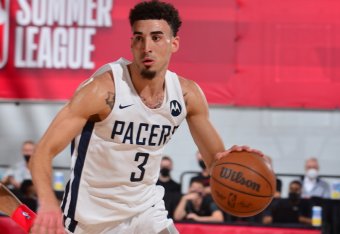
Grading Every Top NBA Rookie at 2021 Las Vegas Summer League
The 2021 NBA draft class showed out in Las Vegas for summer league.
There were far more individual winners than disappointments, from the top picks to the non-lottery prospects and the handful of inevitable second-round steals.
We graded each lottery prospect who played at least three full games in Las Vegas while highlighting the standouts who were slept on during draft night.
Incompletes
1 of 14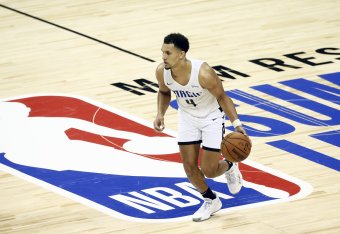
Jalen Suggs' summer league cut short
Suggs hurt his thumb against the Boston Celtics during his third game, cutting his summer league short. But he did get in two full games prior. And he was productive in both, finishing with 24 points and nine boards against the Golden State Warriors and 16 points and five assists against the Cleveland Cavaliers.
He clearly looked like Orlando's top prospect while showing off his pull-up game, passing skills and athleticism around the rim at both ends. It's not often you see point guards throwing down putback dunks and racking up three blocks in a night.
Working with Cole Anthony, Suggs wound up scoring more than playmaking. But it seemed evident he had enough vision and IQ to thrive as a lead ball-handler, while his five smooth threes felt encouraging after an-and-down season shooting at Gonzaga.
Josh Primo plays two games in Las Vegas after two in Salt Lake City
Primo played four summer-league games total, though only two in Las Vegas. He logged enough minutes for us to get a read on where he is developmentally, a question many scouts asked after he played such a limited role at Alabama.
He was given significantly more freedom to create and play through mistakes with the Spurs. And the positives outweigh the negatives for the draft's youngest prospect, who averaged 14.3 points on just 36.2 percent shooting and 27.6 percent from three.
Primo executed more advanced shots in four games than he did all season in college. Even with all the missed shots, he still looked comfortable on the ball using his handle, pull-up game and floater. His size for his position seemed advantageous, as he was able to get his shot off in the mid-range and paint.
The Spurs have a logjam in the backcourt, and at 18 years old, Primo figures to spend most of his rookie year in the G League. But these summer-league results suggest he's further along than most expected. Based on his shot selection and lack of playmaking, Primo figures to work best as a 2-guard who plays alongside a facilitator.
Cade Cunningham (Detroit Pistons, PG/SG)
2 of 14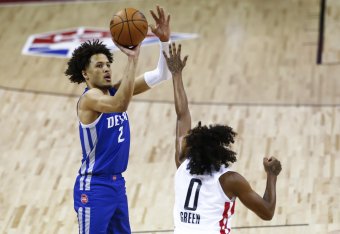
Positives
The Detroit Pistons got a good look at how Cade Cunningham might fit with 2020 lottery pick Killian Hayes. And the first encouraging sign was that Cunningham's shooting looks legitimate. In three games, he buried 13-of-26 threes, drilling jumpers off the catch and dribble with convincing balance and fluidity.
Off the ball, he showed a good feel for getting himself open by making subtle movements or relocations. While many labeled him a point guard in college, his IQ and skill set suggest he's equally suited for reps at 2-guard.
As a ball-handler, he flashes his signature ability to create space into pull-ups with different dribble moves. Cunningham figures to see plenty of ball screens during the season, and he showed good pacing with his hesitations for getting to the rim. Though not explosive, he compensated at times by using his strength to play through contact.
Defensively, he looked smarter than the average rookie, as his anticipation popped throughout his time in Las Vegas.
Negatives
Cunningham had trouble inside the arc at Oklahoma State, and he wasn't any more effective from two-point range this past week (34.8 percent). He struggled to get separation around the key and doesn't always pick the right shot attempt to use in traffic.
In lineups alongside Hayes or Saben Lee, Cunningham spent more time standing around the arc than he's used to. So we didn't get to see much playmaking from the No. 1 overall pick who totaled seven assists to 12 turnovers. He can be too casual, though more on-ball reps and shooters around him should result in a higher assist rate.
Grade: B+
Jalen Green (Houston Rockets, SG)
3 of 14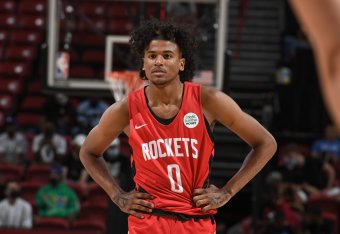
Positives
After watching three summer-league games, the strengths section of Jalen Green's predraft scouting report told no lies. He averaged 20.3 points in 24.1 minutes, demonstrating the shot-creation and shot-making that fuel NBA scoring champion potential.
His advanced ability to create space on jumpers was on full display, though Green didn't need much room. Just as he did in the G League bubble, he got into his step-back with ease and hit difficult dribble jumpers at an outstanding clip.
Green was also effective shooting off the catch, an encouraging sign before he eventually teams up with John Wall.
Aside from his jumper looking sharp (10-of-19 3PT), his elite athleticism popped on various drives. Green's burst and quickness turning the corner is outrageous, almost allowing him to teleport from the top of the arc to the rim in a blink of an eye.
And though not considered a facilitator, he did make basic passing reads out of pick-and-rolls, a set he should receive action in during the season for his blow-by explosion and pull-up game.
Negatives
Green had some trouble when defenses sent pressure the moment he crossed half court. He had four turnovers against the Detroit Pistons, who tried to speed him up and turn a scorer into a passer by trapping and blitzing. He totaled seven turnovers to six assists in 72 minutes.
Defensively, the results were mixed, though no red flags emerged.
Grade: A
Evan Mobley (Cleveland Cavaliers, PF/C)
4 of 14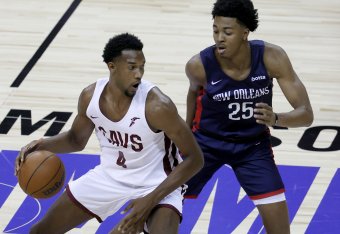
Positives
Versatility sets Evan Mobley apart from most bigs, and his reputation held up in Las Vegas. He flashed a little of everything through three games before being shut down, including face-up play that's just different for a 7-footer.
He converted on pull-ups and drives from the arc and elbows. He showcased his touch on one-handers and fallaways in the paint. And he reminded us of his playmaking potential for a big, racking up six assists against the Orlando Magic, more than No. 2 pick Jalen Green had in three games. Mobley delivered some high-level passes from the top of the key, an area where he figures to have the most success with his mid-range touch and ability to find teammates.
Though a lack of strength is an obvious weakness now, Mobley did try to play through contact, at one point bullying No. 16 pick Alperen Sengun on a dunk after catching an offensive board in traffic.
He also flashed his all-world defensive potential by sliding with guards, covering ground, anticipating shots and using his monster wingspan to contest.
Negatives
Mobley shot an ugly 34.9 percent from the floor, with his lack of lower-body power becoming exposed on back-to-the-basket possessions. His struggles on post-ups at USC carried over to Las Vegas, where he had trouble moving defenders back or gaining position. He was forced to fall away or take awkward shots too often. Mobley, who had 10 turnovers (three games) and an underwhelming 12.0 rebounding percentage, could be stronger with the ball.
His shot looks promising, particularly around the elbows and short corners. And he can occasionally hit the pick-and-pop three. But he still missed seven of eight attempts from behind the arc and doesn't look ready to start regularly threatening defenses from deep.
Grade: B
Scottie Barnes (Toronto Raptors, SF/PF)
5 of 14
Positives
Though not known for being a scorer, Scottie Barnes averaged 15.5 points through four games, mostly by using his ball-handling skills, length around the basket and motor.
He's earned himself dunks by running the floor in transition. But he's also had success in the half court, maneuvering off the dribble, hitting unorthodox one-handers in the paint and drawing fouls.
Barnes flashed some promising touch on his three three-point makes, free throws (17-of-23 overall) and a few mid-range shots out of the post.
Averaging 3.3 assists and 2.0 blocks, his signature two-way playmaking stood out as well. Barnes delivered some high-IQ passes and made outstanding defensive plays on the ball that highlight his incredible wingspan, mobility and awareness. No guard or forward from the draft covers ground or airspace as fast as Barnes.
Aside from his production and versatility, his competitiveness and intensity have been evident.
Negatives
Shooting is still a weakness for Barnes, who missed eight of his 11 attempts from three. And he relied mostly on open lanes and fast breaks for scoring, as he's missing a go-to skill for creating an easy shot (41.2 percent FG) against a set defense.
Grade: B+
Jonathan Kuminga (Golden State Warriors, SF/PF)
6 of 14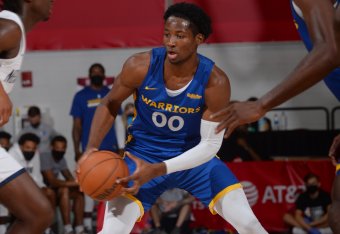
Positives
With at least 16 points in each of his five summer-league games, Jonathan Kuminga was a consistent, three-level scoring threat for the Golden State Warriors.
His mix of power, athleticism and coordination for driving and finishing shined most. He was at his best when focused on getting downhill, where he can play through contact and adjust afterward to hit tough layups. He also showed good footwork, Eurosteps and deceleration to elude defenders, as opposed to going full-speed ahead.
His flashes of creation stood out. Though he can get carried away or hold the ball too long, Kuminga shook defenders with nifty ball-handling moves out of isolation. He isn't known for playmaking, but he also delivered a handful of impressive assists off the dribble, showing both passing skill and vision when he didn't predetermine a shot for himself.
Defensively, it was easy to detect potential tied to his strength and length to guard the perimeter and multiple positions.
Negatives
Kuminga shot 39.7 percent, 27.3 percent from three and 65.7 percent from the line with 17 turnovers, eight assists and 17 fouls in five games.
Questionable awareness led to forced shots and drives into traffic. His jumper isn't reliable and or quick delivery-wise. And he's mistake-prone on defense, as are most teenagers.
Decision-making and shooting issues led to inefficiency, just as they did in the G League bubble.
Grade: B
Franz Wagner (Orlando Magic, SF/PF)
7 of 14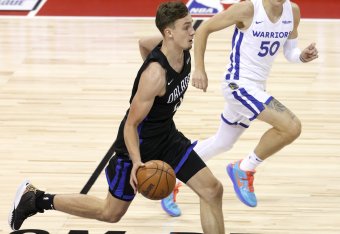
Positives
Not many possessions ran through Franz Wagner, but he clearly operated with a team-first mindset, playing the right way by moving the ball and getting it to playmakers.
As mostly an off-ball weapon in Las Vegas, he generated offense by getting himself open as a cutter and transition finisher. He also converted a few impressive drives past closeouts into finishes, showing off his wing-like movement/coordination for a 6'9", 220-pound forward.
Wagner didn't score a lot, but he made quick decisions and didn't prioritize himself or his stats. "Knows how to play" was a phrase often used to describe Wagner at Michigan, and that was the case in Las Vegas.
Defense is where he'll earn his NBA playing time early on. He put himself in the right position often, appeared alert and gave off veteran vibes with how vocal he was making reads out loud to teammates.
Weaknesses
Creating his own shot was a weakness in college, and Wagner didn't attempt many one-on-one moves with the summer league Orlando Magic. He took six free-throw attempts in four games.
Wagner made a few lazy passes, and he lost the ball off the dribble, showing a need to tighten his handle in the half court.
Poor shooting hurt him most, however, with Wagner just 2-of-13 from three. His jumper looked stiff from NBA distance.
Grade: B-
Davion Mitchell (Sacramento Kings, PG)
8 of 14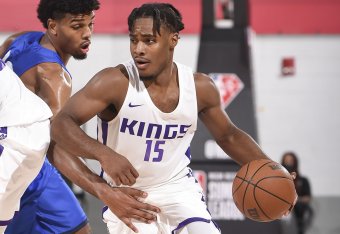
Positives
After a pair of strong games in the California Classic, Davion Mitchell has the Sacramento Kings playing in the Las Vegas Summer League championship game.
He's been difficult to stay in front off, with his absurd burst off hesitation for driving, and a nasty snatch-back move into his dribble jumpers. He goes from zero to 100 as fast as anyone from this draft. Big men who've been forced to switch onto Mitchell haven't stood a chance against his change of speed and direction.
But he also hit four of six threes against the Memphis Grizzlies and two of three versus the Washington Wizards.
Since arriving in Las Vegas, Mitchell has also put more of an emphasis on showcasing playmaking, having averaged 5.5 assists through four games. He's capitalized on all the attention he's generating off the dribble by making the right, simple reads to roll men and shooters.
Defensively, Mitchell has looked as advertised with his quick feet and relentless pressure. Guarding both backcourt positions, a lack of size hasn't held him back from frustrating taller guards.
Negatives
Aside from an off-game versus the Dallas Mavericks (2-of-8), Mitchell hasn't made many mistakes.
He could use his explosiveness more effectively to draw fouls. He hasn't gotten to the free-throw line often (he didn't at Baylor, either), as he's just 1-of-5 in Las Vegas. Mitchell has a tendency to take wild layups in traffic instead of initiating contact or kicking the ball out.
Grade: A
Ziaire Williams (Memphis Grizzlies, SG/SF)
9 of 14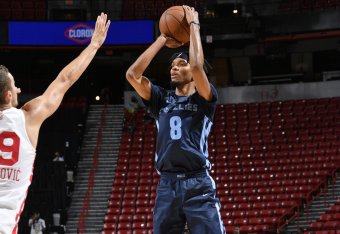
Positives
Despite inconsistent results, Ziaire Williams put together promising highlights of shot-creation and shot-making.
He went 4-of-6 from three versus the Miami Heat, and though his three-ball didn't fall against anyone else, Williams showed off his ability to separate into pull-ups and step-backs in the mid-range.
He also earned himself a handful of easy baskets by flying in transition and crashing the glass.
Williams had some nice defensive sequences as well, moving his feet and keeping the play in front of him guarding pick-and-rolls. He got his hands in passing lanes from off the ball.
Negatives
Williams shot a combined 0-of-14 from three against the Chicago Bulls, Brooklyn Nets and Sacramento Kings. Inconsistent shooting was a theme at Stanford, and it continued in Las Vegas.
His lack of explosion was also evident, as he often settled for pull-ups instead of driving to the rim. Most of his two-point baskets came off broken plays or miscellaneous finishes, as opposed to self-creation skills or off-the-dribble moves. He didn't do much in one-on-one situations or against pressure defense.
Grade: B-
James Bouknight (Charlotte Hornets, SG)
10 of 14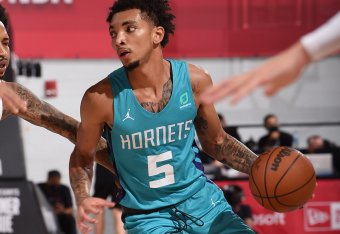
Positives
Viewed as one of the draft's most polished scorers, James Bouknight delivered in summer league with his signature mix of creation and athleticism.
He rarely had trouble separating in Las Vegas with his ball-handling and abrupt explosiveness or step-back footwork that catches defenders off guard. He excelled at finding open space, knowing whether to hit the gas on a drive or stop-and-pop.
Concerns about his shooting percentages started to fade during workouts and the predraft process. And though he needed a 3-of-4 three-point performance against the San Antonio Spurs to salvage his final summer-league stats, the eye test on his jumper remains convincing.
However, arguably the most encouraging development with Bouknight was his playmaking against the Spurs (eight assists) and Toronto Raptors (five assists). His career high at Connecticut through two seasons was five assists. Bouknight delivered some encouraging setup passes to teammate Kai Jones off penetration.
Negatives
Bouknight did too much dancing at times while teammates stood around. The ball stuck. He settled for tough shots and got to the free-throw line 10 times in four games despite a 27.5 percent usage.
Bouknight also had trouble getting separation against the summer league's better defenders like Davion Mitchell and Tre Jones. And outside of the Spurs game, he shot 3-of-12 from three.
Prone to making mistakes at both ends, Bouknight had some rough turnovers and losing gambles on defense.
Grade: B+
Chris Duarte (Indiana Pacers, SG)
11 of 14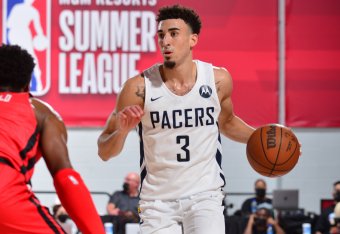
Positives
Considered NBA-ready at 24 years old, Chris Duarte looked like one of summer league's most polished scorers.
You got the feeling he regularly felt like the best player on the floor, demonstrating visible confidence in his one-on-one game and shot-making. There were questions about how his self-creation would translate, and Duarte pulled off a number of high-level moves getting into his jumper or drive.
He hit deep threes, tough pull-ups and physical layups after contact. And he made 14 triples in four games at a 48.3 percent clip, burying them from on and off the ball.
Duarte averaged 3.8 assists, 2.5 steals and 1.8 blocks as well, flashing secondary playmaking skills and an aggressive defensive approach.
Negatives
While Duarte was lights out from behind the arc, he only shot 42.9 percent on two-pointers. His lack of explosiveness and a tendency to force tough shots are to blame. Granted, he was a top option for the Pacers' summer-league team, and he'll be relied on less to create with the NBA squad.
Grade: A
Moses Moody (Golden State Warriors, SG)
12 of 14
Positives
Just as Moses Moody did at Arkansas, he found ways to score in summer league without needing isolation touches or ball screens.
He put up points mostly by catch-and-shooting, attacking in straight lines, finishing in transition and crashing the offensive glass. Shot-making is still Moody's bread-and-butter skill, as he made eight of 18 threes and various pull-ups in Las Vegas.
Moody did flash some self-creation (though nothing fancy), managing to separate just by timing his shot attempt and using his length to convert over defenders.
Despite offering limited playmaking ability, he added value with his passing, showing high IQ on certain reads.
Defensively, Moody did a good job staying attached to guards and wings, and though adding strength is an obvious priority, the Warriors coaching staff figures to feel comfortable using him early for his three-and-D.
Weaknesses
No explosiveness or advanced ball-handling held back Moody in the half court. He shot 41.7 percent inside the arc, relying mostly on open shots or lanes to score.
He had some trouble finishing in crowded areas, lacking lower-body strength and plus-athletic ability.
Grade: A-
First-Round Standouts
13 of 14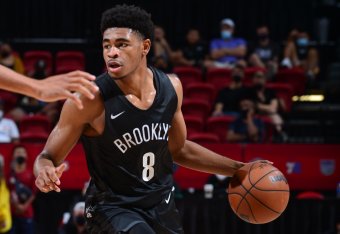
Alperen Sengun (Houston Rockets, C, No. 16 pick)
Sengun is leading all rookies in rebounds per game and tied for first in blocks per game while averaging 14.5 points. The MVP of the Turkish BSL continued to feast with his scoring instincts, ambidexterity and footwork. But it's the flashes of shooting touch and face-up dribble moves that suggest there is far more offensive upside for the Rockets to unlock.
Trey Murphy III (New Orleans Pelicans, SF/PF, No. 17 pick)
After four games, Murphy is 11-of-25 from three while averaging 16.3 points, 1.8 steals and 1.3 blocks. His shot-making carried over, but he's also made plays around the rim that highlight exciting athletic ability. Assuming New Orleans put extra stock into the three-and-D archetype during its prospect search, the Pelicans should feel good about their pick at No. 17.
Jalen Johnson (Atlanta Hawks, SF/PF, No. 20 pick)
The No. 7 player on Bleacher Report's big board fell to No. 20, where it looks like the Hawks found a steal. At 19.0 points per game, he is fourth among rookies in scoring and tied for second in rebounding (9.5). Johnson converted some fantastic finishes in transition, but he also looked sharper than advertised as a shooter with five threes in four games. His athleticism, face-up game, passing and improving touch create unique versatility and star potential that too many teams overlooked.
Isaiah Jackson (Indiana Pacers, PF/C, No. 22 pick)
Jackson was active in limited minutes, mostly by tapping into his quickness, bounce and motor for finishes, putbacks and blocks. His plus-13 is tied for second among rookies with teammate Chris Duarte. And he tied a summer-league record with seven blocks on Monday.
Josh Christopher (Houston Rockets, SG/SF, No. 24 pick)
Christopher struggled from three, but he still managed 16.0 points and a surprising 4.0 assists per game. He showed off his self-creation in the mid-range and athleticism as a transition weapon and slasher. And he defended with energy and toughness, using his powerful legs against bigger wings.
Quentin Grimes (New York Knicks, SG, No. 25 pick)
After a shaky start, Grimes averaged 23.0 points over his final three summer-league games. Though he's limited inside the arc, his shooting, decision-making and defense hint at an easy fit and role-player potential.
Nah'Shon Hyland (Denver Nuggets, SG, No. 26 pick)
Third among rookies in scoring, Hyland lived up to his reputation as a human microwave with creative moves and streak shooting skills. He even averaged 4.8 assists, looking more capable as a playmaker than he did at VCU, where he carried a huge workload as a No. 1 option.
Cameron Thomas (Brooklyn Nets, SG, No. 27 pick)
Thomas led all freshmen in scoring at LSU, and he'll finish summer league leading all rookies. He had two games with 30-plus points, burying defenses with his pull-up game from the mid-range and deep. The No. 9 prospect on Bleacher Report's board fell all the way to No. 27, where the Nets figure to have added a major steal who'll add instant offense off the bench.
Second Round/Undrafted Standouts
14 of 14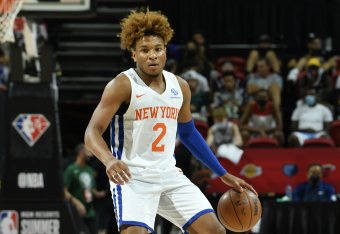
Jeremiah Robinson-Earl (Oklahoma City Thunder, PF, No. 32 pick)
Robinson-Earl's skill and IQ served him well in summer league. A fundamentally sound forward, the Villanova product showed off his soft hands, encouraging shooting touch, rebounding motor and flashes of driving ability past closeouts.
Herbert Jones (New Orleans Pelicans, SF, No. 35 pick)
The Pelicans could see Jones as a rotation player after watching his defensive versatility, IQ and impact in Las Vegas. Though he didn't score a lot, his ability to guard, make reads, pass and finish plays was evident and felt translatable.
Miles McBride (New York Knicks, PG/SG, No. 36 pick)
McBride has made a strong case to receive NBA minutes with his shot-making and defense. He hit at least five threes in three games while playing on and off the ball and pestering opposing ball-handlers into tough jumpers and turnovers.
Sharife Cooper (Atlanta Hawks, PG, No. 48 pick)
Cooper has already started to make most of the NBA look silly for betting against his size and shooting. He's third in summer league in assists (7.3), and he made five threes against the Indiana Pacers, including a buzzer-beater winner. Even if the scoring doesn't translate, his passing will.
Luka Garza (Detroit Pistons, C, No. 52 pick)
Garza's improved shooting and passing showed up in summer league, making it easier to picture an NBA fit.
Jericho Sims (New York Knicks, C, No. 58 pick)
Sims' strength and bounce translated to easy baskets, shot-blocking and a two-way contract. He shot 81.0 percent from the floor.
Sam Hauser (Boston Celtics, SF, undrafted)
Shooting always gave Hauser a chance at making a roster, and he's been one the most accurate in Las Vegas, hitting 10 of 22 threes before the championship game.
Eugene Omoruyi (Dallas Mavericks, PF, undrafted)
Shooting 19-of-22 inside the arc, Omoruyi has been productive around the basket with his strength and touch.
DeJon Jarreau (Miami Heat, PG/SG, undrafted)
The AAC's Defensive Player of the Year at Houston, Jarreau ranks second among rookies in summer league in assists (6.8) while averaging 11.5 points, showcasing improved perimeter scoring skills off the dribble.









